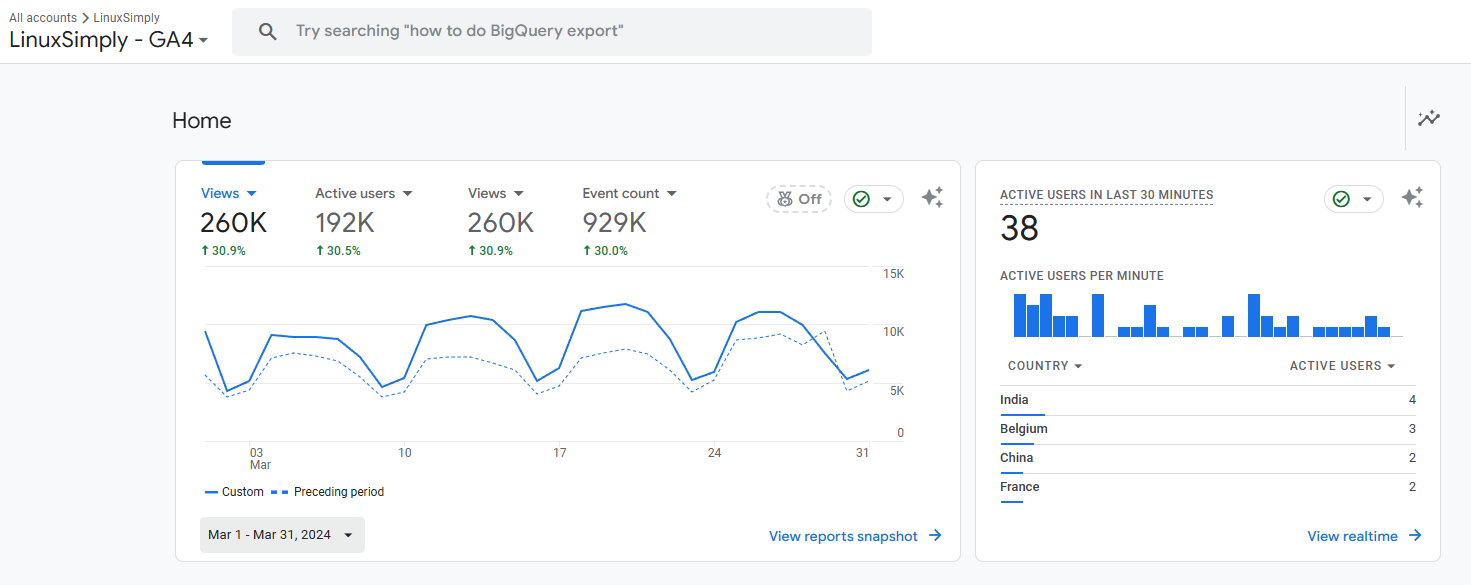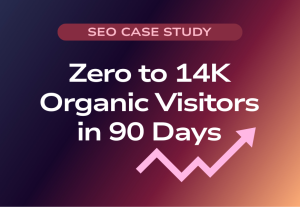How We Scaled LinuxSimply to 260K Visits in 8 Months
We started with a blank page, zero visitors, and an audacious dream: to teach the world Linux — for free.

Project Overview
- Client: SOFTEKO (In-house project)
- Timeline: September 2022 – April 2024
- Role: SEO Project Manager
- Industry: Tech Education
- Niche: Linux Education and Tutorials
LinuxSimply is an online platform offering Linux tutorials, cheat sheets, courses, services, and a support forum. We aimed to create a powerful content ecosystem that attracts millions of Linux users. Then nurture them through high-quality resources, and generate revenue via display ads and course sales.
Initial Challenges
We started with a brand-new domain with no history, no backlinks, and a tough crowd of competitors. We wanted to help the global Linux users with free guides, YouTube tutorials, a support forum, and fundamental courses. But the road ahead was highly competitive.
Here’s what we faced:
- No ready keywords: I had to deeply understand Linux topics to find and organize around 5,000 meaningful keywords into a topical map.
- Scattered topics: I turned random keywords into a structured content network, using a semantic SEO framework. I created parent-child relationships among the topics for meaningful internal linking and clear site navigation.
- No reference content briefs: As our competitors weren’t aware of rich content briefs, we had to build it from zero, based on real research and competitive analysis.
- Tough competition: We were up against big names like LinuxHint, FreeCodeCamp, Hostinger, Cloudways, etc. Still, we managed to win featured snippets and rank #1 for tons of topics due to our strategy.
Despite focusing on many low-traffic keywords, we ranked and pulled in thousands of users over time. The secret? High-quality content crafted to answer users’ questions clearly, and get picked up in featured snippets, People Also Ask, image packs, and AI overviews.
What Were Our Goals & KPIs
We had a few clear goals:
- Maximize the ROI.
- Become an authority in the Linux education niche.
- Reach 100K monthly traffic in 12 months — we beat that by growing to 260K!
- Sell our courses on Udemy and our own site.
- Build a significant brand search volume.
- Get monetization approval from premium ad networks like Raptive.
To support our goals, we additionally launched:
- A YouTube channel with a view to publishing tutorials.
- A Linux forum for peer support.
- Tech services like Bash script automation, server management, and system administration help.
What Were the Tools We Used
We used a variety of SEO, writing, and tracking tools, including:
- Ahrefs, Semrush, Keywords Everywhere: For competitive analysis, keyword research, & backlink audits.
- Screaming Frog, SEO Minion, Detailed SEO: For conducting technical audit & on-page checks.
- Google Search Console, GA4, Bing Webmaster, Clarity: For tracking and analysing performance data.
- Google Sheets & Docs: For the topical map creation, writing content, and content backend planning.
- WordPress (Elementor + Gutenberg): For website building & designing.
- Permalink Manager & Yoast SEO Plugin: For maintaining a clean URL structure, custom breadcrumbs, XML sitemap, and SEO guidance.
- Schema Markup Generator + Google Rich Results Test: For winning rich snippets on Google SERP.
- Slack, Discord, Snov.io, Zoho Mail: For internal communication, collaboration, and outreach campaigns.
Our Bespoke Strategy & Execution
We planned and executed everything exclusively optimized for the project, Linuxsimply. Here’s the detailed breakdown of it:
Semantic SEO & Topical Mapping
The whole strategy was based on Semantic SEO—making our content easily understandable by both humans and search engine bots. I planned a comprehensive topical map based on semantic SEO principles and Koray Tuğberk GÜBÜR’s framework. The map structured over 5000 keywords into parent-child hierarchies to define clear topic clustering, internal linking, breadcrumb structure, tags, categories, and URL structure. This laid the foundation for being a topical authority within a very short period of time.
Technical SEO
- We used a variety of schema markups such as Person, Organization, Website, BlogPosting, How-To, and FAQ.
- We maintained a clean and structured HTML format, especially for step-by-step guides, using accurate coordination of <ol> and <li> HTML tags.
- We developed a desktop tool using Python to automate WordPress’s messy list formatting fixation. This helped get us featured in snippets with text + code blocks—something that helped us beat even the top competitors.
- We maintained easy-to-follow URL structures with a WordPress Plugin called Permalink Manager Lite.
- We added easy-to-follow breadcrumbs for clear navigation with the help of the Yoast SEO plugin.
- We optimized Core Web Vitals with the help of Google Lighthouse and the WP Rocket plugin.
On-page SEO
- We followed Koray Tugberk’s Semantic SEO Framework.
- We maintained rich heading structures (H1 to H4) with carefully placed keywords.
- We maintained a special format; Answered definitions using “is” sentence structures under an H2 heading.
- No first-person or opinions in the answers—just clear and helpful info.
- Used numbered and bullet lists for clarity.
Content Strategy
Our content wasn’t just good—it was one-of-a-kind. We studied the top 10 competitors but went further, adding new ideas from our own tests. We included special sections no one else had, making our guides stand out. Cool infographics that worked as cheat sheets got shared everywhere, bringing us links and fans. Every guide was designed to shine in Google’s images, videos, and extra links. Our full setup—blog, YouTube videos, forum, and paid services—made LinuxSimply a home for Linux fans.
Backlink Strategy
We didn’t beg for links; we earned them by making awesome content. By focusing on quality, we got 4,600 links from 575 websites, boosting our Domain Rating (DR) from 0 to 45 in just a year. It showed that great work brings rewards. But I suggest a strategic link-building from the beginning to get faster results.
Results That Speak
| Metric | Started at | Reached to |
|---|---|---|
| Monthly Pageviews | 0 | 260,000 |
| Ranked Keywords | 0 | 25,916 (690 in top 3, 2,618 in top 10) |
| Domain Rating | 0 | 45 |
| Backlinks | 0 | 4,600+ |
| Revenue (Ads) | 0 | $10,000 MRR |
| Courses Sold | 0 | 57 |
| YouTube Subscribers | 0 | 2,800 |
| Brand Search Volume | 0 | 90/month |
We successfully ranked for high-intent queries, dominated SERP features (Featured Snippets, Sitelinks, PAA, Image Packs), and outperformed Linux giants.

Just imagine this graph soaring upward — that’s what happened!
Key Learnings
- Start with a business model—SEO is just one part of the journey.
- Semantic SEO and topical mapping are non-negotiables in competitive niches.
- Structuring HTML for SERP parsing gives a strong technical edge.
- Passive backlinks from real value > any outreach strategy.
- Know your platform (Google, YouTube, Udemy) and speak its language.
What I’d Do Differently
Next time, I’d combine paid campaigns with organic strategies to accelerate growth, especially in the early stages. Integrating Google Ads, retargeting, or YouTube Ads could have made our flywheel spin faster.
The Final Words
LinuxSimply’s journey wasn’t just a project—it was a dream that came true. From nothing to a powerhouse, we took on the giants and won, building a place Linux fans love. This isn’t just a story; it’s proof that you can achieve the impossible with heart and hustle. Let it spark your big dreams and send shivers of excitement down your spine.


